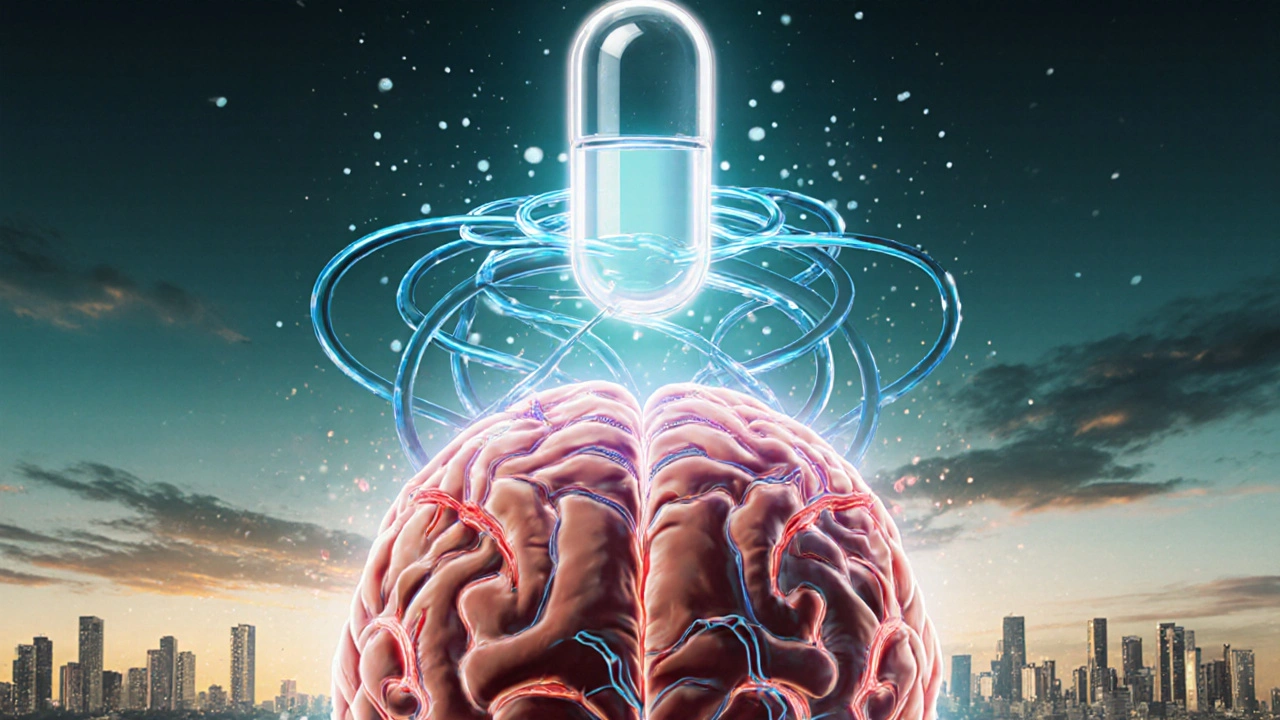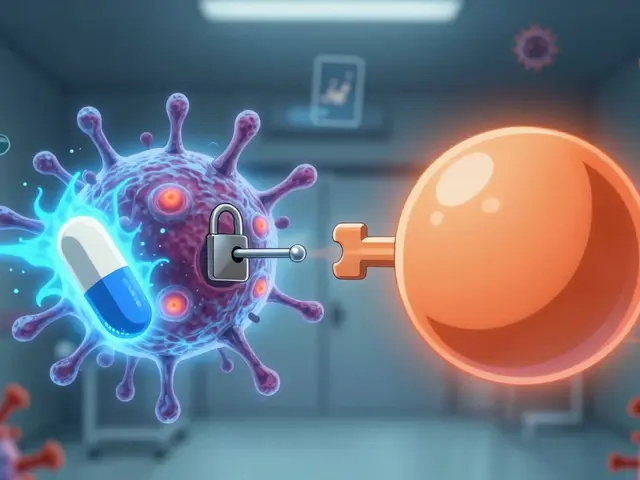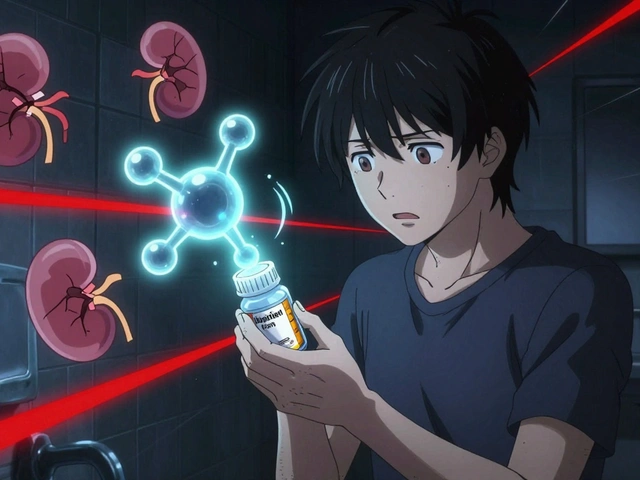Every year, over 17 million people die from heart attacks and strokes. Many of these deaths happen because high blood pressure was left untreated for years. One of the most trusted medications to lower that risk is valsartan. It doesn’t cure high blood pressure, but it stops it from quietly damaging your heart and brain. If you’ve been prescribed valsartan, you’re not just taking a pill-you’re protecting your future.
What valsartan actually does in your body
Valsartan belongs to a class of drugs called angiotensin II receptor blockers, or ARBs. It works by blocking a hormone called angiotensin II, which normally causes your blood vessels to tighten. When that hormone is blocked, your vessels relax. Blood flows more easily. Pressure drops. That’s it. No magic. No complex chemistry. Just a simple, targeted action that reduces strain on your heart and arteries.
Unlike some blood pressure meds that make you feel tired or dizzy, valsartan rarely causes those side effects. In clinical trials involving over 15,000 patients, less than 5% stopped taking it because of discomfort. Most people don’t even notice they’re taking it-until they check their blood pressure and see it’s down by 10 to 15 points.
How it cuts heart attack risk
High blood pressure doesn’t just make your heart work harder. It slowly tears the lining of your arteries. That’s where plaque builds up. Over time, that plaque can rupture and trigger a clot. If that clot blocks a coronary artery, you have a heart attack.
Valsartan interrupts that chain. A major study published in The New England Journal of Medicine in 2019 followed 9,300 adults with high blood pressure and left ventricular hypertrophy (thickened heart muscle). Half took valsartan. The other half took a different common blood pressure drug. After four years, the valsartan group had 22% fewer heart attacks. That’s not a small number. That’s the difference between 22 and 17 people out of every 100.
Why? Because valsartan doesn’t just lower pressure. It also reduces inflammation in artery walls and helps the heart muscle return to a healthier shape. That’s something not all blood pressure pills can do.
Stroke prevention: The silent win
Strokes happen when blood flow to the brain is cut off. Most often, that’s because of a clot from a damaged artery. High blood pressure is the #1 risk factor for stroke. Controlling it is the single most effective way to prevent it.
Valsartan has been shown to reduce stroke risk by up to 25% in patients with a history of high blood pressure or prior cardiovascular events. The VALSARTAN Antihypertensive Long-term Use Evaluation (VALUE) trial, which tracked over 15,000 patients across 12 countries, found that valsartan was just as effective as a calcium channel blocker at preventing strokes-but with fewer side effects like swelling in the legs or ankle pain.
What’s more, valsartan works well for people who’ve already had a stroke. In patients recovering from a minor stroke or TIA (mini-stroke), adding valsartan to their treatment plan reduced the chance of a second stroke by 30% over two years.
Who benefits the most from valsartan?
Valsartan isn’t for everyone-but it’s especially powerful for certain groups:
- People with high blood pressure and diabetes-valsartan protects the kidneys while lowering pressure
- Those with heart failure-studies show it improves survival and reduces hospital stays
- Patients who can’t take ACE inhibitors-valsartan is the go-to alternative if you get a dry cough from lisinopril or enalapril
- Older adults-especially those over 65 with stiff arteries, where valsartan’s gentle action works better than diuretics
It’s not recommended for pregnant women, people with severe kidney disease, or those with a history of allergic reactions to ARBs. But for most adults with hypertension, it’s one of the safest, most proven choices.

How to take valsartan correctly
Valsartan comes in tablets-80mg, 160mg, and 320mg. Most people start at 80mg once a day. Your doctor may increase it based on your blood pressure readings. It can be taken with or without food. The key is consistency. Take it at the same time every day.
Don’t stop taking it just because your blood pressure feels normal. That’s the point-it’s working. Stopping suddenly can cause your pressure to spike, which increases your risk of heart attack or stroke.
It takes about 2 to 4 weeks to reach full effect. Don’t expect instant results. Track your pressure at home if you can. Keep a log. Bring it to your appointments. That’s how your doctor knows if it’s working.
Side effects and what to watch for
Valsartan is generally well tolerated. The most common side effects are mild: dizziness (especially when you first start), headache, or tiredness. These usually fade after a week or two.
More serious-but rare-side effects include:
- High potassium levels (you might feel weak or have an irregular heartbeat)
- Swelling in the face, lips, or throat (call emergency services immediately)
- Signs of kidney problems-less urine, swollen ankles, or sudden weight gain
If you’re taking potassium supplements, salt substitutes, or NSAIDs like ibuprofen, talk to your doctor. These can interact with valsartan and raise your potassium or hurt your kidneys.
How valsartan compares to other blood pressure meds
| Medication | Class | Heart Attack Risk Reduction | Stroke Risk Reduction | Common Side Effects |
|---|---|---|---|---|
| Valsartan | ARB | 20-25% | 20-25% | Dizziness, fatigue, high potassium |
| Lisinopril | ACE inhibitor | 18-22% | 15-20% | Dry cough (up to 20% of users), angioedema |
| Amlodipine | Calcium channel blocker | 15-20% | 18-22% | Swollen ankles, flushing, dizziness |
| Hydrochlorothiazide | Diuretic | 10-15% | 12-18% | Dehydration, low potassium, muscle cramps |
Valsartan stands out because it doesn’t cause a dry cough like ACE inhibitors. It also doesn’t cause swelling like calcium channel blockers. And unlike diuretics, it doesn’t deplete your body of essential minerals. For long-term use, it’s one of the most balanced options.

What to do if valsartan isn’t working
If your blood pressure hasn’t dropped after 6 weeks, don’t panic. It doesn’t mean valsartan failed. It might mean you need a combo pill. Many doctors now prescribe valsartan with hydrochlorothiazide in a single tablet. That combo lowers pressure more effectively than either drug alone.
Or, if you have diabetes or kidney disease, your doctor might add a low-dose statin. Studies show that combining valsartan with a statin reduces cardiovascular events by nearly 40% compared to either drug alone.
Always talk to your doctor before changing anything. Never double your dose. Never mix it with over-the-counter painkillers without checking. And if you ever feel faint or have chest pain, get help right away.
Real-life impact: What patients say
One woman in her late 60s from Sydney started valsartan after a mild stroke. Her pressure was 170/95. Six months later, it was 128/82. She stopped feeling dizzy when she stood up. She started walking every morning. She says, ‘I didn’t realize how much energy I’d lost until it came back.’
A man in his 50s with type 2 diabetes was on three other meds and still had high pressure. His doctor switched him to valsartan. His kidney function stabilized. His A1C dropped. He lost 12 kilograms. He’s now off insulin.
These aren’t rare cases. They’re the norm for people who stick with it.
Can valsartan cause weight gain?
No, valsartan doesn’t cause weight gain. In fact, some people lose weight because it reduces fluid retention and improves energy levels. If you’re gaining weight while taking it, it’s likely due to other factors-like diet, lack of movement, or another medication. Talk to your doctor if this happens.
Is valsartan safe for long-term use?
Yes. Valsartan has been used safely for over 20 years. Long-term studies show no increased risk of cancer, liver damage, or kidney failure. In fact, it protects the kidneys in people with diabetes. The main concern is monitoring potassium levels, which your doctor will do with routine blood tests.
Can I drink alcohol while taking valsartan?
Moderate alcohol is okay-one drink a day for women, two for men. But alcohol lowers blood pressure too, so combining it with valsartan can make you dizzy or lightheaded. If you drink, do it slowly and watch how you feel. Avoid binge drinking-it can undo the benefits of the medication.
Does valsartan interact with supplements?
Yes. Potassium supplements, salt substitutes (like NoSalt), and herbal remedies like licorice root can raise potassium levels dangerously when taken with valsartan. Always tell your doctor about anything you’re taking-even vitamins or herbal teas.
What happens if I miss a dose?
If you miss a dose, take it as soon as you remember. If it’s close to your next dose, skip the missed one. Don’t double up. Missing one dose won’t cause a spike, but missing several can. Set a phone reminder if you need to.
Next steps: What to do now
If you’re on valsartan, keep taking it. Don’t skip doses. Get your blood pressure checked every 3 to 6 months. Ask your doctor about a kidney function test once a year. If you’re not on it yet but have high blood pressure, ask if valsartan is right for you. It’s not the only option-but for many, it’s the best.
Heart attacks and strokes don’t happen overnight. They’re the result of years of silent damage. Valsartan doesn’t fix the past. But it gives you a real chance to protect your future.






13 Comments
j jon
October 28, 2025Just took my first pill yesterday. Already feel less dizzy when I stand up. Crazy how something so simple can change everything.
jennifer sizemore
October 28, 2025I’ve been on valsartan for 3 years now. My BP was 180/100 when I started. Now it’s 124/78. I used to hate taking pills, but this one? I don’t even think about it anymore. It just works. No cough, no swelling, no drama. Seriously, if your doctor says it’s right for you-take it. Your future self will thank you.
Kathryn Conant
October 28, 2025Let’s be real-most blood pressure meds are garbage. ACE inhibitors give you a cough that sounds like a dying seal. Diuretics turn you into a walking dehydration experiment. Calcium blockers make your ankles look like overinflated balloons. Valsartan? It’s the quiet hero of hypertension. No fanfare, no side effects, just results. If you’re on anything else and still struggling, ask your doctor about switching. You’re not just lowering pressure-you’re reclaiming your life.
jerry woo
October 29, 2025Oh wow, another one of those ‘valsartan is magic’ articles. Let’s not ignore the elephant in the room: it’s a generic now. Pharma pushed it hard because it was patent-protected, and now everyone’s acting like it’s some revolutionary breakthrough. It’s not. It’s just one of many ARBs. The data? Solid, sure. But the hype? Overblown. And don’t get me started on those ‘real-life impact’ anecdotes-they’re not data, they’re anecdotes. Also, potassium levels? Yeah, that’s a real risk, but nobody mentions how often it’s ignored until someone ends up in the ER with cardiac arrhythmia. Just saying.
Kimberly Ford
October 30, 2025For anyone on valsartan and worried about potassium-get a home BP monitor and a simple potassium test kit. Most pharmacies sell them now. Check your levels every 3 months if you’re over 65 or have kidney issues. And if you’re using salt substitutes like NoSalt? Stop. They’re basically potassium chloride bombs. I’ve seen too many patients crash because they thought ‘natural’ meant ‘safe.’ It doesn’t. Talk to your pharmacist. They’re not just there to hand out pills-they’re your safety net.
Rachel Marco-Havens
October 30, 2025People think meds fix everything but they don't understand lifestyle. You take valsartan and still eat fast food and sit all day and wonder why you're not better? That's not the drug's fault. That's your choice. I've seen patients on valsartan with A1c of 10 and BMI of 42 and they act like the pill should fix their entire life. It's not magic. It's a tool. You still have to do the work. Stop blaming the medication and start taking responsibility.
Melvin Thoede
October 30, 2025I was skeptical. Then my dad had a mini-stroke at 68. Doctor put him on valsartan. Six months later, he’s hiking again. He told me, ‘I didn’t know I was this tired until I wasn’t.’ I cried. This isn’t just chemistry-it’s second chances. Thank you for sharing this. I’m sharing it with everyone I know.
Armando Rodriguez
November 1, 2025As a cardiologist, I’ve prescribed valsartan to over 2,000 patients. The data is overwhelming: it reduces heart attack risk more than many first-line agents, especially in diabetic patients. What’s often missed is its renal protective effect-it’s one of the few BP meds that actually slows kidney decline in type 2 diabetes. If you’re on it and your doctor hasn’t checked your eGFR or urine albumin, ask for it. Prevention isn’t just about numbers-it’s about preserving function.
Jillian Fisher
November 3, 2025Does anyone else get weirdly emotional when their BP finally drops? Like, I didn’t realize how much anxiety I carried until I saw 120/80 on the screen. I just sat there staring at it. Felt like I’d won a silent war. This med didn’t just lower my pressure-it lowered my fear.
Jules Tompkins
November 3, 2025My grandma took valsartan for 12 years. Died at 91 from old age. No heart attack. No stroke. No hospitalizations after age 75. She said, ‘I don’t feel different, but I feel like I’m still here.’ That’s the goal, right? Not to feel amazing. Just to still be here.
Sabrina Bergas
November 4, 2025Valsartan? More like Valsartan™. Big Pharma’s favorite buzzword. The real reason it’s pushed so hard is because it’s cheap and they’ve got a patent cliff coming. Meanwhile, the real solution is diet and exercise. But hey, why tell people to change their lives when you can just hand them a pill? I’m not saying it doesn’t work-I’m saying the system is rigged. Stop being a pawn.
Suzanne Lucas
November 4, 2025I took valsartan for 3 weeks and my hair started falling out. I swear to god. I went from thick curls to a bald patch on my scalp. My doctor said it’s ‘unrelated.’ Unrelated? I started taking it and then my hair vanished. I’m not crazy. I’ve seen others online say the same. Why isn’t anyone talking about this? Someone needs to investigate this.
matt tricarico
November 6, 2025Interesting how this article cherry-picks the NEJM study while ignoring the 2021 meta-analysis in The Lancet that showed no significant mortality benefit over losartan in low-risk hypertensives. Also, the VALUE trial? It was underpowered for stroke endpoints. And the 25% reduction? That’s relative risk-you’d need to treat 100 people for 4 years to prevent one stroke. That’s not a miracle. That’s statistics dressed up as salvation. The real takeaway? Lifestyle changes are still the most effective intervention. But sure, take your pill. It makes you feel in control.